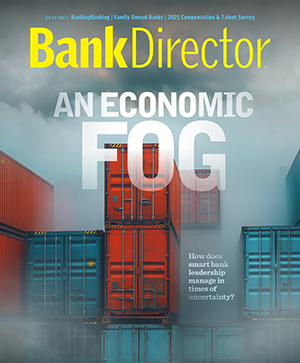Eugene Ludwig is the former comptroller of the currency, CEO of Ludwig Advisors, managing partner of Canapi Ventures, and chairman of the Ludwig Institute for Shared Economic Prosperity.

Bank Leadership in a Deregulated Era
As the regulatory landscape shifts, bank boards can no longer afford to be passive recipients of examiner guidance.
Brought to you by Ludwig Advisors

Anticipated regulatory shifts could transform the bank oversight landscape. While the responsibility for effective oversight has always rested with bank leadership, intense and persistent regulatory scrutiny may have unintentionally allowed directors and executives to rely on external regulatory validation. With examiners deeply embedded in institutions, boards may have become accustomed to assuming that regulators would catch any emerging problems. Deregulation places the responsibility for proactive oversight squarely on bank leadership. This offers a compelling opportunity for greater autonomy and strategic thinking but also carries the risk of missteps in a less-prescriptive environment.
This shift is particularly noteworthy given the recent history of regulatory focus. For years, examiners have broadened their focus far beyond bank balance sheets, dedicating significant attention to the how of bank operations and governance. Specific Federal Reserve and Federal Deposit Insurance Corp. guidance, a section of the Office of the Comptroller of the Currency handbook dedicated to director responsibilities and consistent mentions of board responsibilities in major enforcement actions all underscore this emphasis. But regulatory oversight — both of bank operations and governance — may be waning. As Acting FDIC Chair Travis Hill has suggested, a renewed emphasis on balance sheet management may be on the horizon for the regulatory community. However, this will not release boards and management from their responsibilities. Indeed, it probably heightens them.
The very architecture of bank governance has, for too long, been built on shifting sands, lacking the bedrock of empirical evidence. Supervisors, in their design of board and management structures, have often proceeded without the benefit of rigorous, data-driven analysis or structured effectiveness reviews. This has left boards to rely on best practices and personal observations, struggling to definitively measure their own impact.
This lack of a firm foundation has led to a diffusion of focus, with boards often dedicating significant time to areas where their expertise is limited and their impact questionable. Consider, for instance, the oversight of day-to-day operations. How often must a board, relying solely on the management reports that have become overly copious due to regulatory demands, focus on operational issues that don’t contribute to safety and soundness or compliance? This misfocus on valuable board time, while well-intentioned, often amounts to little more than a costly exercise in information overload, diverting attention from more critical responsibilities.
But beyond the trivial, boards are often tasked with addressing risk and compliance issues through the lens of amorphous, hard to execute concepts. For example, risk appetite, while a frequent topic of regulatory pronouncements, lacks a similar practical application. While considered a major board responsibility, its utility as a concrete management tool remains elusive, often becoming more of a theoretical exercise than a driver of meaningful action.
Strategic planning often suffers a similar fate. While boards are charged with setting strategic direction, the detailed execution inevitably falls to management. Too often, strategic planning becomes a perfunctory ritual rather than an ongoing process of adaptation and innovation. The board’s true role lies in providing high-level guidance, challenging assumptions and ensuring strategic alignment.
In stark contrast to these areas of diminishing returns, management selection and oversight stand as the most significant lever a board possesses. The board’s approach to selecting, incentivizing, evaluating and replacing the chief executive — this is where a board can truly shape an institution’s destiny. This is where their focus must be sharpest.
Moreover, boards also need to focus on obtaining the right information for risk and compliance oversight. Too little thought has been given to the specific data boards should have access to and the levers they should be able to pull to effectively oversee these critical areas.
At the same time, as boards rethink their oversight roles, they should be mindful that examination teams may be less focused on detailed reviews of bank operations. Boards must ensure management pays sufficient attention to identifying and remediating potential operational issues and regulatory compliance challenges.
As the regulatory landscape shifts, bank boards can no longer afford to be passive recipients of examiner guidance. They must reclaim their true purpose: strategic leadership. Without the safety net of constant examiner oversight, the management quality — and the board’s ability to select, oversee and course correct that leadership — becomes the ultimate arbiter of a bank’s success or failure, along with the board’s understanding of and action on bedrock safety and soundness and compliance issues.


